|
Word Gems
exploring self-realization, sacred personhood, and full humanity
Editor's 1-Minute Essay: Part II
The Meaning of Beauty
return to "Beauty" main-page
Ernest Becker, The Denial Of Death: “… the fear of the reality of the intense focalization of natural wonder and power; the fear of being overwhelmed by the truth of the universe as it exists, as that truth is focused in one human face.”

On his website, Dr. Rupert Sheldrake posted a video-lecture, “Why Is There So Much Beauty In The World?” I found his discourse to be extremely thought-provoking and valuable. As this is a subject to which I’ve given some attention over the years, but now with keener focus thanks to Dr. Sheldrake’s talk, I would like to add a few comments of my own.
Aquinas on Beauty: unity, harmony, and clarity
As discussed in the first “1-minute essay,” Thomas Aquinas asserted that “a thing of beauty will possess the three qualities of unity, harmony, and clarity. These are objective standards of beauty, that is, standards residing in the object itself.”
Or not. Distance or proximity might create an illusion of these three qualities of order. I’m reminded of talks that I sometimes enter into with a physics-major friend of mine who insists that straight lines occur in nature. I don’t think so, but when they seemingly do it becomes an issue of perspective. Euclid was wrong, and I offer discussion on this elsewhere. I mention this here because of Edna St. Vincent Millay’s poetry, that “Euclid alone has looked on Beauty bare.” But Euclidian interplay of mathematical harmony is only apparent, not real, as we live on a spherical world which itself is situated, they say, in curved space.
What does this mean for us? Sometimes the “distance or proximity” allowing us to perceive Beauty is not 3-dimensional in nature but one of “closeness” of another sort, that of inner-connectedness, a “union of spirits,” as “The Wedding Song” phrases it. I will come back to this.
do bees see the beauty of a flower
Bees seem to be witnessing something that's attractive; the intense color of flowers seems to be a drawing element in the pollination process. Or maybe it’s the scent or something else that summons the bees. We can’t be sure. But let’s grant for the moment an ability to bees to access the “beauty” of flowers. Would this acknowledgment of beauty on the part of the bee correspond to human appreciation of Beauty?
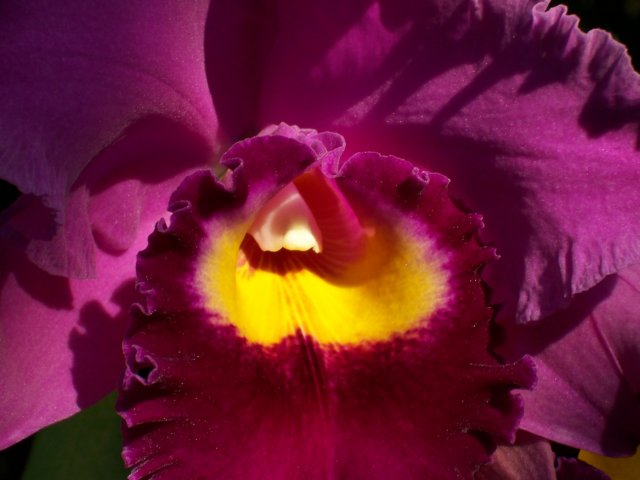
That’s not possible.
Dr. Daniel Robinson, in his Oxford lectures on the work of Immanuel Kant (see them on youtube), asks the question, does a dog see a tree? A simple question but not so easy to answer. It’s clear that the dog sees something as it's able to navigate its way for purposes of urination-marking, but “does the dog see a tree as a tree?” The dog may see a large object with rough exterior, one of general vertical placement, but “does the dog see a tree as a tree?” To see a tree as a tree represents a high level of cognition.

stimulation, perception, conception
The dog undoubtedly knows that a large vertical object of rough exterior blocks its path, but to see a tree as a tree requires a certain abstract knowledge, an awareness of a general category of “trees,” as opposed to a certain individual tree. To see a particular tree as part of a larger family of "trees" is a quantum leap, far too high even for good jumpers like dogs.
Dr. Robinson makes an extremely valuable comment by drawing distinction among stimulation, perception, and conception. A lower form of life might be incited to movement by a shaft of light, that is, mere stimulation as a result of photon activity.
Editor’s note: I sometimes make reference to my young-teen state of mind, rather, a lack of it, by comparing a boy's lower level awareness to a worm vaguely aware of a light source. This is not advanced sentience but mere “stimulation.”
And if the bees “see” the flowers, and have some minimal awareness of the “beauty” of color, I would suggest that any such appreciation of floral beauty would be on par, or lower than, that of the dog which does not see a tree as a tree.
Perception, as we learn from Dr. Robinson, moves us up the line of cognitive awareness. A perception is an awareness of stimulation. I think the dog lives on this level. It is aware of stimulation, and also perceives trees, but does not mentally conceive of trees as trees.
Conception takes us a step further, a gigantic one, wherein perceptions are categorized now as ideas of the world, sorted into general headings. An apprehension of Beauty would follow this order of cyber-evolvement.
the meaning of beauty
Dr. Sheldrake is famous for his work concerning “morphic fields” and “morphic resonance.” It’s a very interesting area and I would recommend watching a few of his youtube lectures on this important topic. Essentially, things that are similar are attracted to each other across space and time -- the greater the similarity, the greater the attraction. And some of this attraction would fall into what we know as Beauty.
Editor's note: Dr. Sheldrake informs us that morphic fields are holistic in nature; that is, you can't break a field into pieces. For example, if a magnet is divided we don't get two parts, one with a north-pole and the other with a south; instead, each piece becomes a complete magnet in its own right. If a flatworm is cut in half, each part repairs itself to form a complete worm. As such, Dr. Sheldrake suggests, what we commonly view as "healing," the human body repairing itself, should be viewed within a context of morphic fields. There is no genetic answer here. Genes are coded to produce particular proteins and do not contain "little blueprints" of final product. The "blueprint" idea associated with genes is a myth. The cells in one's arm are the same as those in a leg, and yet the identical cell-based DNA of arms and legs works to build different body parts. What is the nature of this orchestration? A pile of building materials might be used to construct a barn, a grocery store, or a cathedral. How is the determination made? A large corpus of evidence suggests the existence of morphic fields. "The big idea is that the laws of nature are more like habits. There's a kind of memory in nature. Things happen because they've happened that way before. Every species has a kind of collective memory. Every individual draws on that collective memory and, in turn, contributes to it." Listen to Dr. Sheldrake's lecture.

Special note: Dr. Sheldrake asserts that the "shaping" influence of morphic fields is most insistent among entities which are most alike; identical twins, he says, offer a primary example, the interplay between whom does not diminish with distance as per "quantum entanglement." I will suggest, too, based on testimony of the great Spirit Guides, that Twin Soul lovers are never out of contact and "never separated," influence each other unwittingly, and enjoy their own morphic field. See "The Wedding Song."
Aquinas’ baseline definition of Beauty involving “unity, harmony, and clarity” takes on new strength in Dr. Sheldrake's “morphic resonance” as he views the universe as a long chain of interconnected being, from particles and microbes, all the way up to galaxies and clusters of galaxies. See the discussion of morphic fields in my "Evolution" article.

He speaks of “nested hierarchies,” a grand inter-connectedness of parts within parts, wholes within wholes, with each level of complexity serving as basis for the next level of harmony and order. This spiraling-upward matrix of cosmic integration, this "unity, harmony, and clarity," Dr. Sheldrake feels, is what we subliminally access when we feel that something is “beautiful.”
multiple levels of order and harmony
I believe that Dr. Sheldrake is on the right track. But I think there’s more to the nature of Beauty, aspects of "unity, harmony, and clarity," which extend beyond, or supersede, our 3-dimensional world.
Allow me to address this issue of Beauty within the context of a favorite subject on the Word Gems site, that of authentic romantic love.
The great mystic-teachers inform us that Twin Soul lovers perceive each other in terms of ideal. Each for the other becomes the most wonderful, the most “beautiful,” the "most" in every category.
Is this assessment real?
For Twins it is. She may or may not win a “Miss Universe Contest,” but this is not his concern. For him, she is and always will be “the most beautiful girl” in the cosmos.
How does this idealization happen? Because it involves an awareness of Beauty, it will have something to do with “unity, harmony, and clarity,” but not, strictly speaking, on a level of pleasant outward form. In other words, he will count her as “most beautiful” not because he’s measured bodily features, has determined perfect physical symmetry and balance, and then comparing this quantification to the "perfection" of others. No, nothing of that sort will matter to him in the least; because, whatever she brings to him will be perceived as "perfect beauty."
But if her beauty, as utterly superlative, cannot be accounted for on the level of physical perfection, what then is the source of the “unity, harmony, and clarity” that so bedevils him?
it's existential Beauty, not of the body, per se
Kairissi and Elenchus in “The Wedding Song” offer some good clues:
Kairissi. Ellus, I think a good way to identify and label feelings of romance is to see them under two major headings: Mother Nature and Madame Destiny. Mother Nature is concerned with perpetuating the human family. She cares nothing for love and affection, as such, only the production of offspring.
Elenchus. Only Madame Destiny is concerned with lovers’ intimacy of thought-life; only she is bothered with soul development; only she would promote a “blending” of hearts and inner person. These two iconic women, Nature and Destiny, would lead us to different paths.
K. How confused is the world about these conflicting paths. John chooses Mary on the basis of Nature, but Twins are all about Destiny.
When Twin Souls, caught in each other’s force-field, gush to exclaim, “you are most beautiful to me,” they are not speaking as John and Mary, fever-driven by the temporary purposes of Mother Nature -- those ephemeral evaluations of beauty, as the Beatles sang, "that have a nasty habit of disappearing overnight."
None of that common-fare disaster known in our world as "falling in love" is in view here. And how quickly those possessed by that fading demon lose their perceptions of beauty.
The authentic and eternal romance is not centered in the glories of the youthful body but is concerned with Eternal Destiny. Held in trance by her eyes, he is stunned, often speechless, to seemingly gaze upon, if only subliminally, a vision of his entire future and the reason for his creation. In a moment, an "eternal moment of now," as he staggers to contemplate, he witnesses life's Meaning and Purpose coming alive for him. It's an apprehension of "existential Beauty," not of the body, per se, but of the soul.
|
every angel is terrible...
“For beauty is nothing but the beginning of terror which we are barely able to endure, and it amazes us so, because it serenely disdains to destroy us. Every angel is terrible.” Rainer Maria Rilke, First Duino Elegy
Editor’s note: "Duino" is the name of a castle in Italy where Rilke, after hearing a voice as he walked near the Adriatic cliffs, began writing his Elegies. The whispering voice, whose testimony would become the first line of the lamenting poems, proclaimed, "Who, if I cried out, would hear me among the hierarchies of angels?" Severe depression would interrupt his writing, to be completed rather quickly some years later in a "boundless storm, a hurricane of the spirit."
Rilke, in the Elegies, it seems to me, endeavored to communicate a personal vision of love as ultimate reality. "Angels," for him, represented a transcendental expression of beauty, a higher reality, unattainable to man while on the Earth-plane. Occasionally, we might catch a glimpse, but even a fleeting insight terrifies us. Man's encounter, indeed, a confrontation, with existential Beauty underlies our loneliness and separateness, our striving toward, our inability to substantially access, the divine, while in this world. Rilke perceived a unity among life, love, and death, in that, true lovers will not be able to touch ultimate love while hampered by mortality: "the nature of every ultimate love ... is only able to reach the loved one in the infinite."
Editor's note: "Every angel is terrible [and] the beginning of terror." Not without reason men truly in love cannot sometimes breathe or speak in the presence of a Beloved as she symbolizes Beauty Personified. Her "made in the image" status, as we've discussed, conveys to him a nearness to God that shall not be superseded in this life or, likely, the next. This "terrible" ensign of God's perfect essence becomes all the divinity he is able to bear; yes, "Every angel is terrible," as she "serenely disdains to destroy" him, both with presence and absence. There is reason why a man truly in love finds himself compelled to "worship and adore" his Beloved.
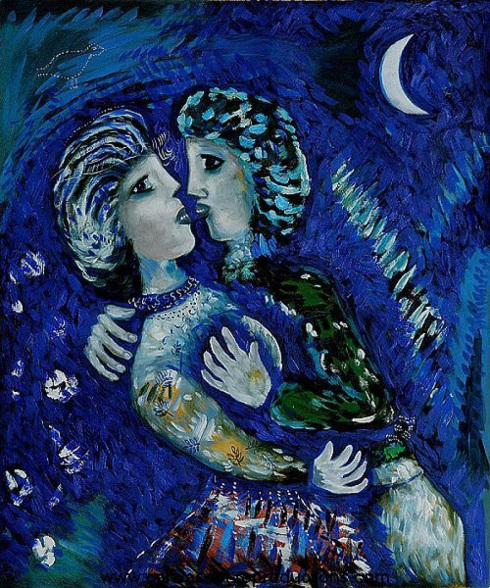
Marc Chagall, Lovers with Half Moon, 1926
|
It’s the ultimate “beatific vision.” He’s never seen anything more beautiful… the zenith of “unity, harmony, and clarity”... Suddenly, everything's as it should be, all is in order, "all snowflakes fall to their appointed place," nothing is lacking, with all desires satisfied... as the heavens open with her accepting smile.
who could ask for anything more...

The Happenings, I Got Rhythm, 1967
“I got my girl, who could ask for anything more”
In her presence, he is granted a sense of wholeness and completeness previously unknown; class is in session, life's meaning unfolds in her radiance, in her sparkling eyes, as he now enters a higher level of consciousness, perceiving the ultimate in "unity, harmony, and clarity."
|
Ernest Becker, The Denial Of Death: “… the fear of the reality of the intense focalization of natural wonder and power; the fear of being overwhelmed by the truth of the universe as it exists, as that truth is focused in one human face.”
Editor's note: Ernest Becker's words brilliantly capture the sense of "every angel is terrible" as the Sacred Beloved, one's personal "beatific vision," reveals the face of God to her lover.
|
|
Eckhart Tolle, Even The Sun Will Die
beauty as portal to ultimate reality and truth
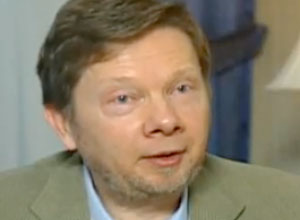
"[The mind might stop] when overwhelmed by tremendous beauty and, for a moment, there’s an opening; and whenever you respond to the beauty in nature, or the beauty of another human being, there’s a moment for the recognition of beauty to be possible, in that, there’s always a moment of thoughtless awareness, and that’s when you truly perceive…"
In The Wedding Song we find authentic lovers engaged in consciousness-enhancing activity: drawing life and giving it back again. Not all of this interaction is pleasant and will sometimes fall under the heading of “sacred combat.” However, a major avenue of access, a portal into greater maturity and awareness, is effected by the concept of beauty.
We learned from Andrew Jackson Davis that true lovers will see each other as ideals and ultimates in every aspect. But this is not the unrealistic, infatuation-driven assessment of John and Mary. True lovers are not blinded to what may be remaining faults and imperfections of the beloved. “Spots and wrinkles” are seen to be what they truly are – heralds of strength and virtue to come.
The true lover sees through present imperfection, all the way to the beauty of the beloved’s hidden nature, all that he or she will yet become in a flowering of human potential; and this existential “beatific vision” of future and ultimate loveliness holds the viewing lover in thrall concerning the majesty and splendor of that which the sacred beloved will one day manifest: “I believe in you, I know who you are.”
|
|
the translucence of the eternal splendor of the One and of the Truth
In 1970 Nobel laureate Werner Heisenberg delivered an address entitled, “The Meaning of Beauty in the Exact Sciences.”
He drew distinction between two definitions of beauty put forth in history:
(1) the concept of beauty as harmonious relational symmetry, a pleasing unity of externals (see the previous essay); but also, from Plotinus,
(2) “Beauty is the translucence, through material phenomena, of the eternal splendor of the One”; further, Heisenberg referenced two Latin mottos, “The simple is the seal of the true,” and “Beauty is the splendor of truth.”
In the essay “What We Stay Alive For,” I suggest that the true mate will see in his beloved this “translucence” revealing the “eternal splendor” and the “hidden face of God.” Only he will see these marvels as she becomes, for him, spiritual pedagogue of divine mystery.
|
channeled information from Summerland, as reported in Excursions to the Spirit World by Frederick C. Sculthorp: He had learned how to astral travel and had visited his departed wife on the other side:
“My first actual meeting with my wife [was] … deeply imprinted on my mind. The indescribable spiritual perfection that I saw in my wife when we were face to face, the sacred intensity of the high vibration, and the later explanation of ‘God's image’ caused me a great deal of quiet thought for days afterwards. I somehow knew that it was one of the eternal and unfailing spirit laws and that it was simple and natural… When I met my wife and our auras intermingled, there was a beautiful and gentle harmony, and we both thought alike and as one mind… In that wonderful meeting there were no thoughts of self. Each thought of the welfare of the other… ‘God's image’ I can still only describe as perfection.”
|
|
|
the sacred meaning of art

Above, I quoted Nobel laureate Werner Heisenberg: “Beauty is the translucence, through material phenomena, of the eternal splendor of the One.”
On the strength of this, along with my own meditations, in the “What We Stay Alive For” writing, I offered that one’s eternal mate, “in the beauty of her countenance, reveals, as no other pedagogue, the hidden face of God… only for him, her beauty becomes a sacred portal to an inner knowing.”
However, beauty as expressed in the fine arts might also become pathway to mystical depths. I would call this “sacred art,” in that it issues as product of the artist’s accessing Universal Consciousness. We discussed this in the “Higher Creativity” article.
Most art today is not worthy of the term and does not reflect higher levels of awareness; instead, most art seems to reach for the sensational, the gaudy, the carnival, the meretricious. When we view it, there is no calling forth of hallowed wonderment from the depths of being.
From “The Seven Purposes,” channeled comment from the other side: “Art, when it is a real interpretation of life, is a high and noble thing, but the art that is merely self-expression [representing the dysfunctional ego] is a disintegrating force. Too much of it is that now."
Instead, we sense that the artist connived, “ok, let’s see if we can turn heads and raise eyebrows by being outrageous, let’s offend proprietous sensibility, and then they’ll think we’re clever and say we’re ‘creative’.”
We often see this same dynamic in the typical published work. The writer seems to believe that good writing is the arresting of attention by way of the scandalous and the coarse, with little regard to the most important part of writing – having something worthwhile to say.
In these works of so-called art there is nothing that leads us to higher ground or deeper perceptions, nothing that points us to the inner knowing, there is no “translucence,” no shining through, “of the eternal splendor of the One.” It’s a purely man-made work devoid of co-creatorship with the divine.
From a grander perspective, however, it’s not just painting and writing, or music and sculpture, that becomes plastic material for the muse – one’s entire life, if properly lived, should reflect a cooperation with the transcendental; one’s very life should become a masterpiece of Universal Consciousness’s expression.
I like quoting Dr. Ernest Becker on this vital point, and have done so on the homepage, but allow me to reference his words again:
Victory "over human limitation is not something that can be programmed by science … It comes from the vital energies of masses of men sweating within the nightmare of creation … The most that anyone can do is to fashion something - an object or ourselves - and drop it into the confusion, make an offering of it, so to speak, to the Life Force.”
|
|
beauty and the inner cosmos
In one of his lectures, Eckhart makes an important point about the night sky. As we peer into the midnight dark-blue, we perceive both objects and an immensity of space around them. But, he says, how can this be? “Space” is not a thing, as such, and so why should we be aware of it? Even to give it a name, “space,” adds to the confusion because, with a name, we reify it, make it a “thing,” turn it into a kind of object.
Space is a “no-thing.” The fact that we perceive it at all -- given that there is so much we do not perceive, especially, the gargantuan immensity of the cosmic “space” -- indicates or suggests a hidden proclivity, in that, a deeper part of ourselves, the “inner cosmos,” the “inner space,” resonates with, is drawn to, this external version.
When I heard Eckhart explain this, I said, yes, of course, and this is very closely related to the meaning of beauty. Just as our sense of awe in observing “outer space” is generated not by the space itself but by an affinity with the "space," the "stillness," of our own “inner cosmos,” so, too, the sense of awe, the majesty of the beauty, which a lover perceives in his beloved, is not, strictly speaking, emanating from the beloved, per se, but from (1) the soul-depths of the loving observer and (2) a perception of the new glorious "One Person" relationship which their love has created (see "The Wedding Song" regarding this latter phenomenon).
|
again, it's existential Beauty, not of the body, per se; only she, one particular girl and no other, can help him see the face of God
No wonder he wants to "worship and adore" her.
He believes all of this wonder to be issuing from her; a not altogether wrong presumption. However, a wider survey reveals a different source of that which dazzles him: it's the Beauty of his soul, his own soul knowing itself in a "union of spirits" with another; that particular other who is no other but part of his own being; that one, in "morphic resonance," more similar to him than anyone else in the universe.
Only she might help him access, and reflect back to him, the perfection, the harmony and order - the Beauty - of his own "made in the image" deepest person.
Each of us, "made in the image," possesses an inner perfection; however, the truth seems to be, only one's Twin Soul can facilitate a realization of this marvel.

|
Vincent van Gogh:
“When facing a flat landscape,
I see nothing but eternity.
Am I the only one to see it?”
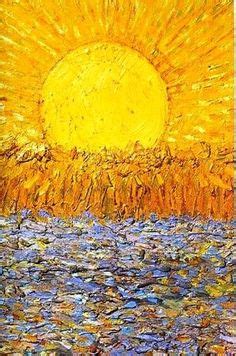
Editor’s note: Originally, I’d made reference to Van Gogh’s ecstasy in a chapter of the book, “How To Sit Quietly In A Room Alone.” See it here.
However, it occurs to me that Van Gogh’s vision of eternity, as a result of communing with the glories of nature, accesses the same spirit of which I speak in this “Meaning Of Beauty” article.
There is something about Beauty that opens a door to the mystical, to the transcendent God, to the infinite, to the inexpressible; opens the heart and soul, and evolves these, as nothing else. I submit to you, here, and in the above discussion, that the opening of this door – this existential vision of unbounded “eternity,” as Van Gogh would have it -- is facilitated by one’s Sacred Beloved, one’s Twin Soul, the unknowable God's "made in the image" agent, more than any other purveyor of the splendid and sublime.
|
|
Editor's last word:
Many love songs, referencing the loss of a beloved, speak to a hopelessness, a future’s bleak landscape; even more, with authentic relationship, the very soul itself, the inner person, so it feels, languishes, is hollowed, in utter purposelessness.
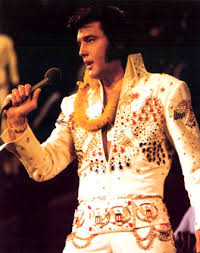
darkness where my soul has been
One such song comes to mind, by Elvis, entitled, “When I’m Over You.” The sorrowful aftermath of losing one’s love, he says, is more than simple tragedy: “There’ll be darkness where my soul has been, and no light will ever shine again…”
What is the nature of this extreme grief and misery? It’s as if one’s very sense of personhood has been eviscerated and emptied. One’s beloved is a source of beauty, to be sure, but why should the loss of this beauty in one’s life become so utterly devastating? Why does it feel like “there’ll be darkness where my soul has been”? with this destitution affecting us so deeply, so completely, as to invite a sense of the impossibility of recovery: “no light will ever shine again.”
There are many sources of beauty in the world: a sunset, a full Moon, a flower, a small child, a bird, a seashore, a mountain – we could go on. As we encounter each of these, we might experience a certain upliftment of the heart. We’re inspired. But then we move on to mundane thoughts and tasks and may never again recall the incident.
no light will ever shine again
But when we lose authentic love, we don’t move on. Now, in greatest calamity, “there is darkness where my soul has been”; moreover, we perceive that there will be no healing from this fall into perdition: “no light will ever shine again.” This is existential crisis at its most profound; a magnitude of loss impinging upon not merely what one has but, it would seem, what one is.
the face of God to him; the closest he will ever come to the Divine during the next million years and beyond
The Sacred Beloved has the didactic power to reach her mate as no other pedagogue in the universe. She is “the face of God” to him, an encounter with the supremely mystical, a doorway to knowing the beauty of his own soul. Not for sport is she labeled as "made in the image."
Editor's note: Spirit Guides inform us that Twin Souls are given to each other -- for many reasons -- but, from a cosmic, evolutionary perspective, these Two are meant to help each other develop spiritually. As this is the case, intuitively, I believe, during times of separation, Twins experience a sense of existential calamity, a period of overreaching grief and sorrow, "darkness where my soul has been," when that one person, one specifically created to lead her mate to higher ground, goes missing.
Only she, the Twin Soul, possesses the key to open long-barred psychic strongholds, without which manumission he would ever remain prisoner to his aloneness, never truly perceiving the meaning of “made in the image.”
READ MORE in "The Wedding Song" concerning "there must have been a reason for becoming man and wife."
There are many pretty faces in the world; in their evanescence, we recover from the loss of these; however, there is a particular one whose loss would invite a calamity from which we shall not recover.
the transforming fire
There are those, many, on the other side of life, who do not understand these things; have not yet discovered true love and its transforming fire. In this bereft condition, they slowly drift into a kind of egoic insanity, a "darkness where the soul has been," an unrealistic view of the nature of reality. For them, "no light will ever shine again" until they prepare themselves spiritually for her coming. This is fact, not poetry.
|
|











